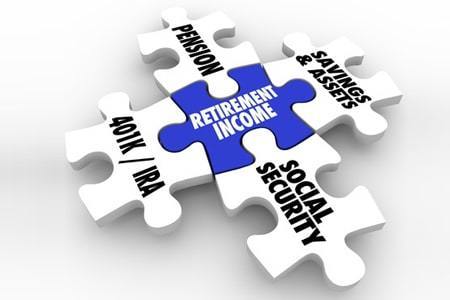Often times I talk to people that don't think they can afford to retire, but they actually can. Others think they need to work for perhaps another 5 or 6 years when they could actually retire perhaps in just a couple of years. Often I find that it's the people that have done the best job of saving over the years that have the hardest time making the transition into retirement and becoming a spender.
If you like your job, and want to keep working that is one thing. However, if would retire if you could afford to do so then it's important to think through some numbers, and consider some of the changes that take place when you are no longer working. You are no longer contributing to your retirement account. You are no longer paying payroll taxes. Also, once Social Security begins that's a tax advantaged income stream. We will talk all about it in this video.

News You Can Use
Get actionable financial advice delivered to your inbox a few times a month.
Full Transcript:
Oftentimes I talk to people that want to retire, but just don't think that they can. And what's interesting to me anyways is that oftentimes it seems that it's the people that have been the best savers over the years that are now the ones that are having the hardest time now making that transition and now becoming a spender. And so I want to share this with you. You can see these numbers on the screen. I'll make this a little bigger here in just a second, but I was talking to a couple earlier today, both in their late sixties, and she's already retired, he's still working, he's making a good income. He didn't mind his job that said if he could afford to retire. He said that he would. But he said more important is that he really didn't want to sacrifice their lifestyle, their standard of living for at least the next 5, 6, 7 years.
They weren't really sure, but there was a lot of traveling and a lot of things that they wanted to do. And he said, I feel healthy. I feel good. I can do it. So I'm in a good job, I'm in a good position. I might as well was the thinking, which is fine if you want to continue. But he also did say as well that, Hey, if I could afford to retire tomorrow and I felt confident that I could, then yes, I would retire. So I said, well, let's just take a look at it because oftentimes I do find that, again, people can't afford to retire, but just don't realize that they can. So let me share this with you. I've changed up some of the numbers, of course, to protect the innocent, as I always say. So I'm not using actual numbers from them, but here's the basics of the situation.
So again, she's retired, he's making $180,000 for the year, and this is the lifestyle that he wants to maintain. Now, from his salary, 30,000 is coming out for a 401(k) contribution. Then he's paying about $34,000 total in taxes. So at the end of the year, basically they're going to have about $115,000 of money to spend for their lifestyle. Now what we want to compare that now to, and by the way, I'm recording this video in November of 2023. These tax rate numbers are based on 2024, which these are estimates. So there could be other deductions or other things in play. I'm just assuming they're both taking the standard deduction and keeping this relatively simple. But I want to show you this concept just like I did with this couple. And so in order for them to have the same lifestyle, for them to have about $115,000 of money to spend for the year if they were to both retire.
So she's already retired, but if he was to retire as well then and if they decided to go ahead and turn on their Social Security benefits now, which it actually might make sense to do something a little different, maybe have one take a benefit now and one wait a little bit. But let's just say they're both to take their benefits now, they're going to get $61,200 for the year, which was 5,100 on a monthly basis. They would also need to withdraw 63,627 from an IRA right there. Now, after doing this, they'll have to pay only about $9,600 in taxes to be left with the 115,000. So this I think is, although I know we all know this, but I think it's real ey eopening when we see this on paper that of course when you retired, when you are retired, you're no longer contributing to your retirement accounts.
The other thing you're no longer doing is you're no longer paying payroll taxes. So that's the Social Security and the Medicare tax that's only taxed while you're working. So there's less income. Social Security is also tax advantaged. I've talked about that in other videos, that Social Security, that's your only income source. It's not taxable on the federal level and it's not taxable in California ever. And so for this couple to maintain this same standard of living, this is what they need. They need to turn on their Social Security and take $63,000 from an IRA. Okay? Now the question is how much do they have to have in their portfolio and their retirement savings in order to support this type of withdrawal? And then presumably to increase this with the cost of living over time. Now, generalized rule of thumb is a 4% rule. If you're not familiar with that, the idea there is that you could take 4% of your portfolio on an annual basis and then increase that for the cost of living.
So if you had a million dollars in your portfolio and you're taking 4%, that's $40,000 for the year, and then the next year you would increase that for the cost of living. So in this case, they need 63,627. So let's take a look at the calculator here, 63,627, we're going to divide that by 4%. They would have to have almost 1.6 million in an IRA. Now with this couple, he had close to $2 million in his 401(k) plan, which is where he would roll over the IRA if retired here. So he had the money even just based upon the 4% rule. Now, there's different rules of thumb here, schools of thought and everyone's retirement's going to look different. Oftentimes what I find people would like to do in retirement is spend more money in the early years of retirement. We sometimes call this the go-go years and oftentimes the years where you want to be the most active in getting out there and doing things, whether it's trips or whatever.
And so for this couple that wanted to maintain that standard of living, one of the other approaches that we could take here is instead of just withdrawing 4% of that portfolio, they may withdraw 5% or maybe 6% of that portfolio. Now, they may not continue to do that on an annual basis for the next perhaps 20 or 30 years of their retirement, but maybe for the first five years or the first 10 years of their retirement, maybe they'll take out a higher amount of withdrawals earlier on, and then they'll kind of scale that back a little bit. Oftentimes I find that people want to spend more money earlier in their retirement years, forget inflation adjusted. Of course that's factored in. But again, because people want to get out there and doing more things, people tend to just want to spend more money earlier on, and then they kind of slow down, don't want to do as much spending.
But the big expense that does still tend to rise, especially in the later years it seems, are the healthcare costs. So this is kind of what we've looked at. And so for this couple, they could see that, okay, yeah, this does make sense and it does look like we can retire. And so now we're actually putting a plan together to really iron it out and see how everything looks. But these are some of the things that you want to be taking a look at. Now, one other thing I wanted to show you here, because it kind of goes with this, is oftentimes I'll talk about having a source of tax-free income in retirement and how that can really help you. And so let's say for instance, they also retired next year, but they also had some money in a Roth IRA. So if that was the case, in order to still meet the same living expenses, let's say that they were going to withdraw $10,000.
You'll see here from the Roth IRA, well, they're still going to get the $61,000 from Social Security that you see right here, this number. But now because they're taking this $10,000 from the Roth, which they're able to get now after taxes, they're only having to withdraw 50,435 from the IRA versus this $63,000 number. Okay? So by doing that again, the Roth is not subject to tax, and the Roth IRA will not cause their Social Security benefits to become taxable. Oftentimes amongst high income earners, once somebody understands how Social Security benefits are taxed, they just assume based upon their income that they're going to have to pay taxes at the 85% rate, which is at the high end. So at the worst with Social Security, you're going to pay taxes on 85% of your Social Security benefits. Even if you make a million bucks a year, you won't make more than 80 or you won't have to pay taxes on more than 85% of your social security benefits.
But for this couple, in either scenario here, they're not having to pay taxes on 85% of their Social Security benefits. It's less. And by having that tax-free income source, the amount of the Social Security that's subject to tax is even less over here. And you can see by just that $10,000 Roth IRA withdrawal into the mix here, it's really reduced the amount of taxes that they would have to pay. What is that? That's over $3,000 in tax savings by being able to take that from the Roth. Okay? So that can be very, very helpful. And depending upon your situation is why oftentimes I'll say it can make sense maybe to incorporate some Roth conversions or have a source of tax free cash that you can access because it can help put you in a better position for retirement. So enough said on this here today, I hope this helps. If you have questions or wondering where you stand for retirement, don't hesitate to reach out and if this video has helped you, feel free to like the video and subscribe and we'll see you in the next one. Take care.
